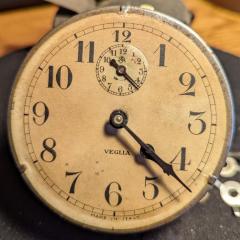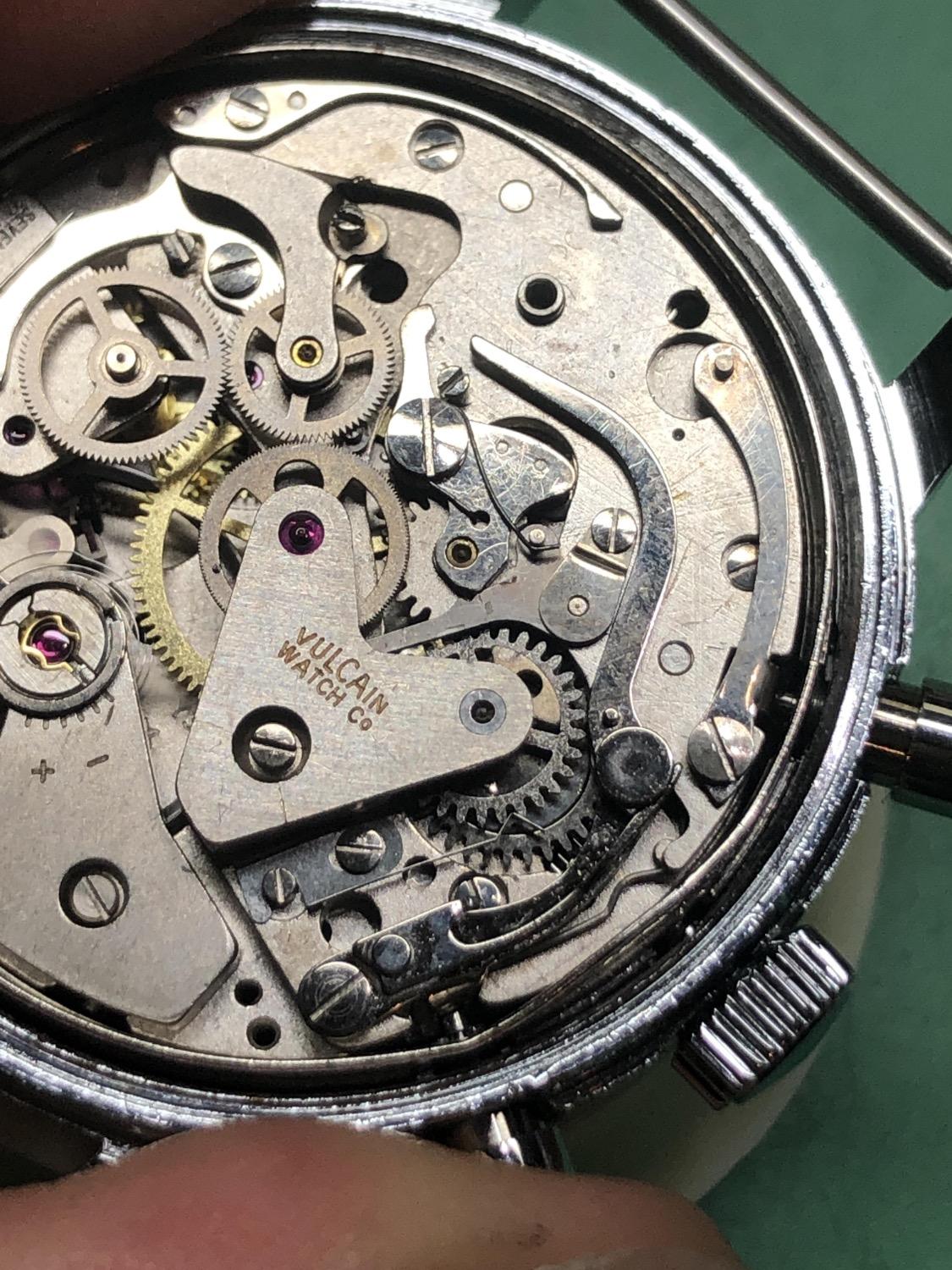Broken barrel arbor.
-
Recently Browsing
- No registered users viewing this page.
-
Topics
-
Posts
-
Hi nev, Balance bottom jewel having been pushed down in the mainplate, weakens my stance and further supports your point, leaving me not much ground to argue with you. Surely you agree that flipping cap stone ( at the least ) is a cost free test to produce more data , before deciding to make a balance staff, which is an advanced task. Us human beings tend to go the route we are familiar with, sure making a balance staff would have solved the problem, which unlike many here, your good at. Frankly, I am beginning to think, you will make a balance staff to cure headaches with, what's more confusing is; you get good results too. 😍 Rgds
-
As @RichardHarris123 has said, the simplest option is to remove the broken stem (may need to be dissolved using alum powder) and use an extender. Can you remove the back and let us know what the movement is.
-
I can't tell you how reassuring it is to see 1min/day positional error & 2-3min isochronal error as an acceptable tolerance for a simple pallet or good pin pallet watch. This makes me much more confident in the performance I recently got out of a 7 jewel and not at all well built Junghans pocket watch caliber. Good time to buy stock in Casio. I almost never work on good quality movements. The handful of Unitas 6498's I have done all had no difficulty reaching >290 (and though 40-50 years old, all those were in like new condition). But otherwise, I mainly have serviced everyday workhorse movements out of old watches like the AS 1187, or Soviet movements. Nothing anyone would classify as high quality. I was seeing something on Watch U Seek or similar, where somebody complained about low amplitude on a Timex. A Timex! I'm still not all the way there with my tooling though. I don't have a microscope, I don't have a Jacot tool. I'm mostly stuck with whatever condition my pivots are in, beyond cleaning them. I imagine there's quite a bit of potential power being lost there. (and still, my question here isn't "how do I get more amplitude" - it's more like "is it just internet hobbyists who are hopelessly obsessed with high amplitude")
-
Why settle for 270? You should strive for more never ever accept less especially with this group I'm assuming for your vintage movement you have the lift angle set correctly? Then proper timing procedure like checking dial-up and dial down looking for pivot faults. Checking the escapement lubrication the condition of the pivots etc. you do end up with some interesting problems on vintage like why don't they publish amplitude specifications? Or for that matter why don't they would publish timekeeping specifications? As the watch companies usually don't publish lift angle before certain point in time because timing machines didn't exist that would measure amplitude which brings up the question of how Did the watchmaker survive without having a timing machine To please. As the most important function as a watchmaker is pleasing the timing machine by getting it acceptably high amplitude numbers who cares about timekeeping? So if you look on timing machine manuals typically they'll make suggestions like in the witschi training course we find this Obviously witschi doesn't know what they're talking about amplitude from 250 hasn't even hit that magical 270. But there is a reference to timekeeping and the beat error. Now is amplitude really that important? Let's look at this in a little different fashion?For instance image out of one of the witschi documents escapement where to the sounds come from? Now let's combine it with another image Let's look at this a little different than you normally do lift angle with the image above tells you the time span that the escapement is screwing up the oscillation of our balance wheel. From the impact of the roller jewel on the fork until locking the escapement is exerting and influence on our timekeeping. The loss of energy on impact with the fork the artificially pushing from the mainspring or basically screwing up timekeeping. So if we were to make comparisons like a watch running at 100° versus maybe 250° with a typical lift angle around 50°. Then on the lower amplitude 50% of our amplitude is under artificial influence versus a higher amplitude where 1/5 influence. So typically a higher amplitude the escapement isn't screwing up things as much. But it also depends on the quality of the escapement the adjustments. Then somewhere in all of this would be the physics of the spinning balance wheel bigger amplitudes possibly better immunity to vibrations shock twisting motion etc. but it also stands on the type of the balance wheel a larger pocket watch friends since the timing machine especially if you have a nifty microphone that rotates by itself it needs more time to settle just because it does and of course amplitude will come into play here so a lot of things amplitude is better but a magical number or death well that's only acceptable on this group.anywhere else timekeeping that's what I spent a lot of time at work doing trying to get vintage pocket watches to keep time. I'm less concerned about amplitude and I don't have a magical amplitude or else. I'm typically looking at things like the difference in dial-up and dial down indicating pivot problems or if it looks really too low than I might go through in figure out the lift angle to make sure that's correct. But the biggest thing is it has to keep time on the timing machine I must please the timing machine or my boss gets unhappy. Fortunately I get paid by the hour so that takes lots of time to please the timing machine So my boss is pleased the world will be good. But the big thing is timekeeping not amplitude unless it looks really bad. Yes the classic problem watch repair discussion groups with the obsession of worshiping their timing machine and a magical amplitude versus what does the watch Due on a wrist where we don't have a timing machine to verify its amplitude. Somebody really needs to get a phone app with clip on microphone with recording so we can keep track of that amplitude when it's on the wrist timekeeping specifications become a problem as I mentioned before as we typically don't get specifications for anything vintage. Timing machine manuals are good as they would give specifications like this comes out the Greiner manual notice no amplitude though how sad Then let's look at typical Swiss not vintage unfortunately. I'm attaching a eta document one of my favorite documents they do is the manufacturing information sheets hard defined as far as I can tell every mechanical and quartz watch probably had one. Filled with all the nifty specifications of everything. Typically when looking at basically anything relatively modern can find timing specifications this is what you're going to see. Number of testing positions better quality watches get more positions normal watches you'd only check at least for specifications I would still personally check in more positions just as a good way of looking for problems or issues but officially for timekeeping purposes they only look at a couple positions increasing as the quality the watch does of course. Then they give you a timing. Timing difference between the various positions this is why a lower grade watches zero I'm looking between two positions not six as this gets harder to do as a number positions go up. The isochronal number this is quite interesting. Basically the difference in amplitude this is where watch that would maintain a even amplitude over 24 hours even if it's not the magical whatever the group expects will keep better time typically the watch that starts at 300 and drops to some lower number. It's also where the shape of the mainspring comes in as the shape of the mainspring will change the power curve. Then we get the classic what is the maximum amplitude because anything over this can cause issues. Note we do not get a target amplitude target timekeeping but not amplitude. Then at the end of 24 hours this is the minimum and it varies between the watch companies. I think Omega might have some watches as low as 160° but they still have to keep time. So yes the most important thing in the universe except for this discussion group is does the watch keep time? How many customers are how many people wearing a watch are concerned about their amplitude?, A Rolex customers are concerned about the amplitude they get really cranky of their watches off by more than one second a day. Oh and no one not kidding about the Rolex customers we had somebody come and they were unhappy with the servicing done some more elsewhere in the past there were happy but this time somebody adjusted the Rolex to the actual specifications but the customer expected much closer to zero. Yes people with watches are obsessed with timekeeping. Witschi Training Course.pdf ETA 6497-1 Manufacturing Information.pdf
-
By nevenbekriev · Posted
Hi Joe, Well, we all know that usually one side of cap stone is domed. No mater of that, flipping the whole plate with the cap stone in it, without shifting the stone, normally doesn't lift the balance. This is because the plate is normallhy thicker or at least of the same thickness as the stone itself. The flat side of the stone is flush with the plate surface, thus the domed side of the stone should not pop above the other side surface of the plate. This means that flipping of the plate should not lift the balance. The hole stone MUST stay flat (or domed) side to the cap stone. If flipped, this may cause the pivot not to reach to the cap stone at all. This depends on the stone thickness and the ivot lenght thow
-








Recommended Posts
Join the conversation
You can post now and register later. If you have an account, sign in now to post with your account.
Note: Your post will require moderator approval before it will be visible.